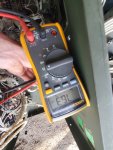Iron.Horse
Member
- 27
- 27
- 13
- Location
- Frederick, Maryland
10 terminal block reads 12.2 on upper wires, not disconnected. Little tricky to get in there. A1 test, with wires disconnected is a crazy bizarre reading in the 60.0 range. I triple checked it and every time got a different reading, but it was definitely no lower than 50-60 ohms



